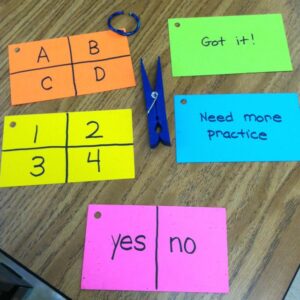What are response cards?
Using response cards is one strategy to increase active student response, whole-class participation and engagement. Response cards are best defined as reusable cards, signs or items which are used (held up) simultaneously by all learners in a class to display their responses to questions or problems presented by the teacher (Gardner, Heward, & Grossi, 1994).
The use of response cards as a tool of whole-group response strategies is a commonly utilized teaching strategy for learners with and without learning disabilities.

When learners have opportunities to respond simultaneously during academic learning, active student participation increases, which has Heward (1994) describes is key to learning.
There is a distinctive correlation between active learner participation/ learner response and increased academic performance as well as learning outcomes (Randolph, 2007). Furthermore, increased opportunities for learner engagement in response to instruction reduces the amount of wasted time and improves on-task behavior and school performance (Blackwell & McLaughlin, 2005).
Why use handheld response cards?
Response cards provide an alternate responding option, which are user friendly in comparison to other options requiring technology. In addition, response cards are low cost and straightforward to use. The most common options include those response cards which are printed index cards for selected response and those response options using a white board and dry erase markers.
Much of the research done around whole-group response strategies, particularly focusing on the use of response cards in the pre-K to 12 setting, show that these strategies lead to:
- Increased class participation and willingness to participate
- Offered immediate feedback to the educator
- Improved test achievement
- Decreased distraction
- Decreased disruptive or unfavorable behavior (Randolph, 2007)
The immediate visual learner response helps the educator to quickly assess, modify or adapt instruction and provide feedback to learners or readjust approach.
There are a few pitfalls to using response cards:
- Sometimes are difficult to read (especially if using mini white boards)
- Distributing materials can take away from instruction time
- Preparation of materials can be time consuming depending on the type of response cards you choose.
Why use response cards versus Hand signals/ Hand raising?

“put your hand up if you are having a good time” by micn2sugars is licensed under CC BY-NC-ND 2.0
Traditionally learners have used hand-raising when wishing to speak. Using a show of hands can still be a popular and fast way to convey decision making or to encourage questioning, however hand-raising has been shown to limit academic engagement and performance for both learners with and without learning exceptionalities (George, 2010). Additionally, hand-raising only allows for one learner at a time to respond when called upon, which can be a challenge depending on the amount of class time. It can also be a struggle for those learners who are not comfortable expressing their ideas, being put on the spot and may be distressing to those learns who require more processing time, those who experience social anxieties or those who have language barriers.
References:
Blackwell, A. J., & McLaughlin, T. F. (2005). Using guided notes, choral responding, and response cards to increase student performance. International Journal of Special Education, 20(2),1-5.
Gardner, R. III., Heward, W. L., & Grossi, T. A. (1994). Effects of response cards on student participation and academic achievement: A systematic replication with inner-city students during whole-class science instruction. Journal of Applied Behavior Analysis, 27, 63-71.
George, C. L. (2010). Effects of response cards on performance and participation in social studies for middle school students with emotional and behavioral disorders. Behavioral Disorders, 35(3), 200-213.
Heward, W. L. (1994). Three “low-tech” strategies for increasing the frequency of active student response during group instruction. In R. Gardner, D. Sainato, J. Cooper, T. Heron & W. Heward, (Eds.), Behavior analysis in education: Focus on measurably superior instruction (pp. 283-320). UK: Wadsworth Publishing.
Randolph, J. J. (2007). Meta-analysis of the research on response cards: Effects on test achievement, quiz achievement, participation, and off-task behavior. Journal of Positive Behavior Interventions, 9(2), 113-128.

